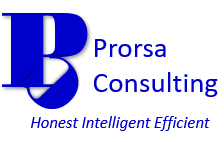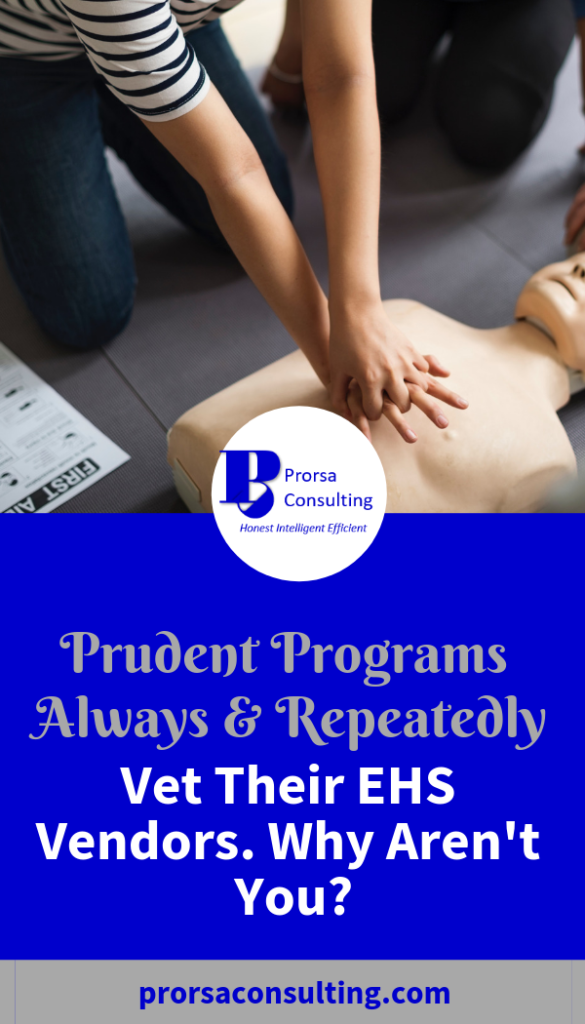Prudent Programs Always & Repeatedly Vet Their EHS Vendors. Why Aren’t You?
By : Admin -

So many items can pose business risks to your operations. Some of these you can’t fully control. However, organizations have a choice in the EHS vendors with which they work. So, why wouldn’t you vet these vendors before allowing them to provide you with products or services?
Regulating entities, customers, and the public hold companies responsible for any activities occurring within their facilities’ fence lines. As such, organizations have a vested interest in how their EHS vendors’ products or on-site activities may impact sites.
Companies with prudent environmental & safety programs have taken notice of the influence EHS vendors can have. Furthermore, they adopt systems into their overall EHS program management for vetting service/product providers. This occurs before finalizing their EHS vendor work relationships and periodically as long as the working agreements exist. What’s keeping your organization from doing the same? Read on for information to get you started with your EHS vendor reviews.
Disclaimer: Please be aware that this blog post may contain affiliate links and any purchases made through such links will result in a small commission for Prorsa Consulting (at no extra cost for you). Feel free to visit our Disclosure of Material Connection page for more information.
EHS Vendors: Work with your company’s procurement team.
In most situations, your organization’s procurement team will serve as the liaison between you and EHS vendors during the initial selection process. In order to secure an opportunity to properly vet EHS vendors, you must work closely with your internal procurement personnel.
By working with procurement, an initial EHS vendor review can be integrated into your organization’s already established purchasing process. This will help avoid possible confusion on the part of your EHS vendors. It also makes things easier on vendors with only one process to navigate. Moreover, you eliminate the risk of duplication of efforts between procurement management and EHS program management.
So, consult your procurement personnel early on with the specifics of what you want to accomplish. This will help facilitate any feedback procurement may have for you and get the process moving forward.
EHS Vendors: What information should get a review?
Items like company viability and pricing should fall squarely within the responsibility of procurement. After all, that’s part of the reason to get this internal personnel engaged. EHS needs to outline the pertinent environmental, health, and safety data that should be checked to determine the associated risks.
So, what exactly does that entail? Statistics like injury/incidence rates, past regulatory citations, and employee training history provide an excellent place to start when predicting probable future EHS performance.
In addition, any specialized licensing or certification that may impact EHS should be investigated. For those wishing a more thorough review, an inspection of an EHS vendor’s in-house procedures will provide invaluable information.
Image by Rawpixel on Unsplash.com.
EHS Vendors: Methods to employ for data collection.
When thinking about how to collect data for EHS vendor reviews, companies should try to ensure the collection process serves its purpose without placing an undue burden on the vendor. Remember, there is a potential working agreement to be made here. As such, organizations want the process to be a positive one for vendors.
The easiest data collection method would be a simple questionnaire submitted to the vendor for completion. Companies can develop one in-house and simply include it an EHS vendor’s initial paperwork for completion.
Another method would be to employ an outside party to collect the desired EHS data from vendors. This route usually carries monetary costs for the company requesting the data and/or the EHS vendor. These third-party service data collections can integrate into an organization’s internal procurement process.
Moreover, third-party services can require significant lead time and people resources to properly implement. However, once up and running this route can reduce the workload of internal staff as the outside service provider completes the bulk of the data evaluation work. ISNetworld, BROWZ, and Avetta (formerly PICS Auditing) are just a few service providers organizations may want to consider if this method of data collection is desired.
If an organization wishes to take a more hands-on approach, EHS vendor audits can supply a wealth of information concerning vendors’ internal EHS practices. Furthermore, audits of this nature provide opportunities to observe vendors’ activities in live, real working situations while also giving a chance for data review.
EHS Vendors: Determining a review frequency.
The frequency of EHS vendor reviews should align with the organization’s overall EHS program management strategy. Companies should strive for a review schedule that ensures proper due diligence without causing unnecessary disruption for themselves or their EHS vendors.
Of course, EHS vendor reviews should take place before hiring a new vendor. This gives the opportunity to bring EHS matters into the decision-making process on whether or not the vendor should receive your business.
However, it is important to conduct periodic on-going reviews to ensure EHS vendors continue to maintain the excellent EHS performance that won them your business in the first place. Depending on your organization’s industry and its level of regulation, these reviews may need repeating every 6 months to 3 years.
Organizations should also use common sense to guide the scheduling. For example, if an EHS vendor has a required license that expires every 12 months, then that vendor should undergo review annually to ensure the license remains current. If this is not the case, then a longer review period may present a better fit.
The data collection method also may dictate the EHS vendor review frequency. For instance, your organization nor your EHS vendors may have resources to conduct an audit every year. As such, a biennial review period may be a more acceptable frequency.
Safety Department of One: Tips to Managing EHS Program Success with Limited Time and Resources
from: Online Compliance Panel
Other Articles Related to EHS Program Management You May Enjoy
Keep An Eagle Eye on Secondary Containment for Improved Environmental Management
Continuously Kick the Tires on Your Back Injury Prevention Program
Simple Ways to Dip Your Toe into Environmental Sustainability in Business Today
7 EHS Compliance Business Tips to Implement Today for Quick Wins Starting Tomorrow
Parting Thoughts
Making proper vetting of EHS vendors an integral part of your EHS program management will help to ensure the organization receives excellent services and products. Moreover, it gives your organization an avenue to potentially reduce its EHS risk from vendors’ activities.
Prorsa Consulting’s guiding mission is to assist companies just like yours with determining and reaching their EHS goals. Whether your goals are compliance or management based, Prorsa stands ready to help. Check out our Services page for more information on what we have to offer. Feel free to email contact@prorsaconsulting.com with questions concerning our services.
We encourage your feedback on this blog’s content. Be sure to like and/or share below. You can also give us your feedback via our Contact Us page.
Don’t forget to follow Prorsa Consulting on Google+, LinkedIn, Pinterest, and Twitter.
Get the tools you need to support your EHS program in our Free Resources area. Just subscribe to the Prorsa Consulting Newsletter below to receive access.


